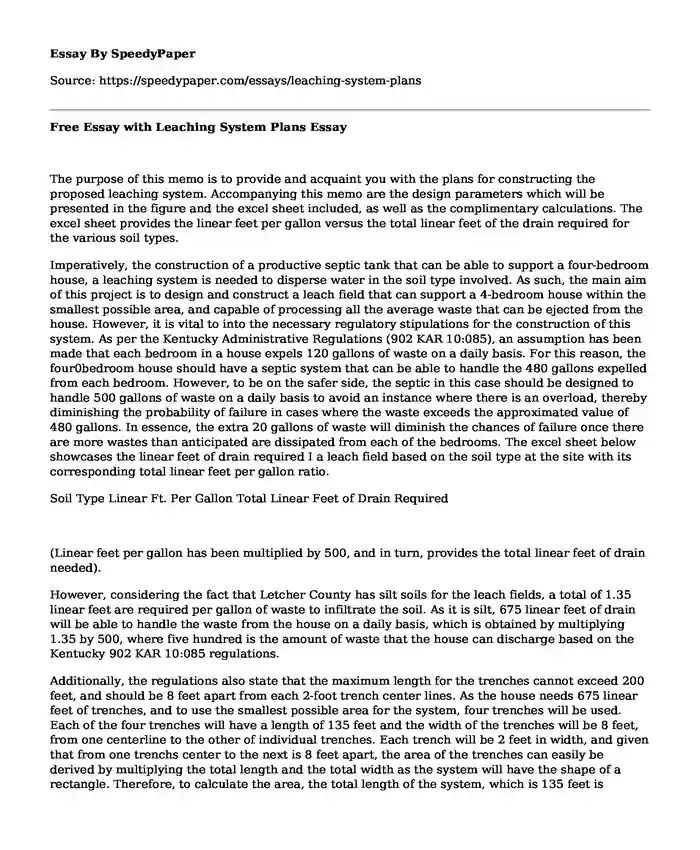
| Type of paper: | Essay |
| Categories: | Engineering Environment Pollution |
| Pages: | 3 |
| Wordcount: | 786 words |
The purpose of this memo is to provide and acquaint you with the plans for constructing the proposed leaching system. Accompanying this memo are the design parameters which will be presented in the figure and the excel sheet included, as well as the complimentary calculations. The excel sheet provides the linear feet per gallon versus the total linear feet of the drain required for the various soil types.
Imperatively, the construction of a productive septic tank that can be able to support a four-bedroom house, a leaching system is needed to disperse water in the soil type involved. As such, the main aim of this project is to design and construct a leach field that can support a 4-bedroom house within the smallest possible area, and capable of processing all the average waste that can be ejected from the house. However, it is vital to into the necessary regulatory stipulations for the construction of this system. As per the Kentucky Administrative Regulations (902 KAR 10:085), an assumption has been made that each bedroom in a house expels 120 gallons of waste on a daily basis. For this reason, the four0bedroom house should have a septic system that can be able to handle the 480 gallons expelled from each bedroom. However, to be on the safer side, the septic in this case should be designed to handle 500 gallons of waste on a daily basis to avoid an instance where there is an overload, thereby diminishing the probability of failure in cases where the waste exceeds the approximated value of 480 gallons. In essence, the extra 20 gallons of waste will diminish the chances of failure once there are more wastes than anticipated are dissipated from each of the bedrooms. The excel sheet below showcases the linear feet of drain required I a leach field based on the soil type at the site with its corresponding total linear feet per gallon ratio.
Soil Type Linear Ft. Per Gallon Total Linear Feet of Drain Required
(Linear feet per gallon has been multiplied by 500, and in turn, provides the total linear feet of drain needed).
However, considering the fact that Letcher County has silt soils for the leach fields, a total of 1.35 linear feet are required per gallon of waste to infiltrate the soil. As it is silt, 675 linear feet of drain will be able to handle the waste from the house on a daily basis, which is obtained by multiplying 1.35 by 500, where five hundred is the amount of waste that the house can discharge based on the Kentucky 902 KAR 10:085 regulations.
Additionally, the regulations also state that the maximum length for the trenches cannot exceed 200 feet, and should be 8 feet apart from each 2-foot trench center lines. As the house needs 675 linear feet of trenches, and to use the smallest possible area for the system, four trenches will be used. Each of the four trenches will have a length of 135 feet and the width of the trenches will be 8 feet, from one centerline to the other of individual trenches. Each trench will be 2 feet in width, and given that from one trenchs center to the next is 8 feet apart, the area of the trenches can easily be derived by multiplying the total length and the total width as the system will have the shape of a rectangle. Therefore, to calculate the area, the total length of the system, which is 135 feet is multiplied by the total width, which is 34 feet, to yield 4,950 square feet. This area is considered the absolute smallest area necessary to hold a 675 linear feet pipe. The figure below highlights the proposed leach field dimensions considered in the calculations made.
Based on my personal opinion, having a septic tank accompany the leach field is totally essential for the project as they help decompose and expel waste. Septic tank effluents are discharged into the trenches where pathogenic bacteria, nutrients, and viruses are removed, destroyed or transformed. The septic treatment unit operates by ensuring that water enters the system, which is allowed to settle for some time. In effect, the accompanying solids sink while the liquids will be pushed to the top where they will flow the leach fields, distributed in the trenches, and finally sips through the soil. The resulting infiltrating liquids act as fertilizers and make the soil more fertile. This essential information is specified in the article, Microbial Diversity of Septic Tank Effluent and a Soil Biomat by Tomaras, Sahl, Siegrist and Spear, and reveals how the system work in treating wastes has been provided.
For this reason, septic tanks and leach fields are efficient and affordable in getting rid of household waste, and I strongly support the use of these systems for the four-bedroom house in Letcher County.
Cite this page
Free Essay with Leaching System Plans. (2019, Nov 18). Retrieved from https://speedypaper.net/essays/leaching-system-plans
Request Removal
If you are the original author of this essay and no longer wish to have it published on the SpeedyPaper website, please click below to request its removal:
- What Is Social Power Essay Example
- Free Essay with the Israel Occupied Territories Research
- Concept Proposal Essay Example: Vancouver Sports Hotel
- How My Extracurricular Activity Has Shaped Me, Free Essay Sample
- Essay Example on Climate Change Problems in the Coral Reefs
- Essay Sample on The Life Of Chief Pontiac
- Big Data Risks and Rewards - Free Paper Sample
Popular categories




